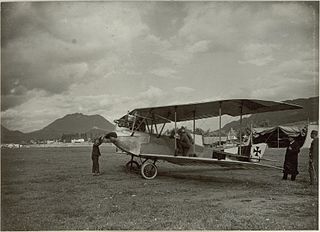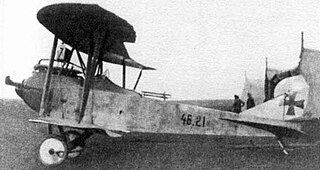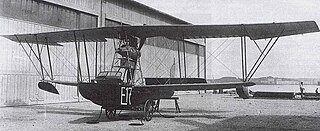 W
WThe Luft-Limousine or Luftlimousine, also known as Etrich VIII Luft-Limousine, was a single engine monoplane built by the Etrich company in Silesia in 1912.
 W
WThe Hansa-Brandenburg C.I, also known as Type LDD, was a 2-seater armed single-engine reconnaissance biplane designed by Ernst Heinkel, who worked at that time for the parent company in Germany. The C.I had similarities with the earlier B.I, including inward-sloping interplane bracing struts. Like other early-war Austro-Hungarian reconnaissance aircraft, such as C-types of Lloyd or Lohner, the Type LDD had a communal cockpit for its crew.
 W
WThe Knoller C.II was a reconnaissance aircraft built in Austria-Hungary during World War I for use by the Austro-Hungarian army. It was a conventional biplane design with staggered wings, and seated the pilot and observer in tandem in an open cockpit. Like Knoller's preceding C.I design, the upper wing was swept back, but not as far as it had been on the earlier aircraft. The structure was wooden throughout, with the wings skinned in fabric and the fuselage in plywood. The interplane struts were made of steel and arranged in a warren truss configuration.
 W
WThe Lloyd 40.05 was a very unorthodox experimental fighter/reconnaissance biplane produced by Lloyd (Ungarische Lloyd Flugzeug und Motorenfabrik AG / Magyar Lloyd Repülőgép és motorgyár Részvény-Társaság) in the Austro-Hungarian Empire during the First World War.
 W
WThe Lloyd C.I was a reconnaissance aircraft produced in Austria-Hungary shortly before and during the First World War, and which formed the basis for a number of other closely related types. It was the Lloyd company's own design, but reflected the DFW designs that Lloyd had previously been building under licence, in particular, in its swept-back, "Pfeil" ("arrow")-style wings. Apart from this feature, it was a conventional biplane design for its day, with staggered wings of unequal span and accommodation for the pilot and observer in tandem, open cockpits. The fuselage was built from welded steel tube, and was covered in fabric. A small load of bombs could be carried internally, to be released by the observer.
 W
WThe Lloyd C.II and its derivatives, the C.III and C.IV were reconnaissance aircraft produced in Austria-Hungary during the First World War. They were based on the Lloyd company's pre-war C.I design, and like it, were conventional biplanes with swept-back wings.
 W
WThe Lloyd C.V was a reconnaissance aircraft produced in Austria-Hungary during the First World War. It was a departure from Lloyd's previous reconnaissance types, which had all been based on a pre-war design. The C.V was a more compact and streamlined aircraft with an unusual wing structure.
 W
WThe Lohner B.I was a military reconnaissance aircraft produced in Austria-Hungary during World War I. As Lohner strove to perfect the design, a variety of increasingly powerful engines were fitted, reflected in a range of military designations from B.II through to B.VI until the definitive B.VII was finally produced. This last version was also produced in an armed variant, designated the C.I.
 W
WThe Lohner B.II was a military reconnaissance aircraft produced in Austria-Hungary during World War I. It was a development of the pre-war B.I design, incorporating changes requested by the Austro-Hungarian army, but inheriting its predecessor's basic design, including its characteristic swept-back wings.
 W
WThe unarmed Lohner B.VII and its armed derivative the C.I were military reconnaissance aircraft produced in Austria-Hungary during World War I. They were the ultimate developments in a family of aircraft that had begun with the B.I prior to the outbreak of war, and were the first members of that family that proved suitable for front-line service during the conflict. Like their predecessors, the B.VII and C.I were conventional biplanes with characteristic swept-back wings.
 W
WThe Lohner E was a reconnaissance flying boat built in Austria-Hungary during World War I. The "E" stood for Igo Etrich, one of the Lohner engineers. It was a conventional design for its day with biplane wings that featured slight sweepback, and an engine mounted pusher-fashion in the interplane gap. Its crew of two was seated in an open cockpit.
 W
WThe Lohner L was a reconnaissance flying boat produced in Austria-Hungary during World War I. It was a two-bay biplane of typical configuration for the flying boats of the day, with its pusher engine mounted on struts in the interplane gap. The pilot and observer sat side by side in an open cockpit, and both the upper and lower sets of wings featured sweepback.
 W
WThe Lohner M was a reconnaissance flying boat produced in Austria-Hungary during World War I.
 W
WThe Oeffag C.II was a military reconnaissance aircraft produced in Austria-Hungary during World War I.
 W
WThe Phönix C.I, given serial numbers in the Phönix 121 range, was an Austro-Hungarian First World War reconnaissance and general-purpose Biplane built by Phönix and Lloyd.
 W
WThe UFAG C.I was a military reconnaissance aircraft produced in the Austro-Hungarian Empire during World War I, by the Ungarische Flugzeugfabrik Abteil Gesellschaft (UFAG). It was introduced in April 1918, and was widely used on the Italian Front in the final months of World War I.